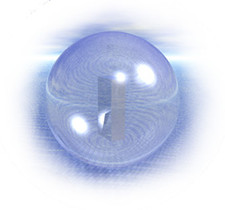Ours is a world where we recognize, visualize and can navigate in three dimensions. Height, width and depth. Physicists can theorize the existence of a fourth, and more, dimensions. However even if one includes Time, (which most of us only have a fuzzy understanding of) in those equations, to really understand anything beyond our three dimensions is nearly impossible for us mere mortals.
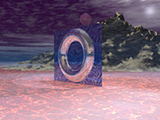 Expressing and conveying even a simple idea, in a way that other people can understand, is difficult. Let alone trying to
explain in detail a three dimensional object that may never have existed before. This is because, other than words,
(which can get pretty confusing) the biggest improvement humans have made to conveying ideas using graphics, since we began
drawing on cave walls and on other flat TWO DIMINSIONAL surface spaces, has been the concept and use of Perspective,
also termed Forced Perspective. That is, until relatively recently, with the invention of computer 3-D graphics.
Expressing and conveying even a simple idea, in a way that other people can understand, is difficult. Let alone trying to
explain in detail a three dimensional object that may never have existed before. This is because, other than words,
(which can get pretty confusing) the biggest improvement humans have made to conveying ideas using graphics, since we began
drawing on cave walls and on other flat TWO DIMINSIONAL surface spaces, has been the concept and use of Perspective,
also termed Forced Perspective. That is, until relatively recently, with the invention of computer 3-D graphics.
If you just read the first two paragraphs, you might understandably be wondering what any of that has to do with fixing your toilet or any other kind of handyman work. The answer is: Probably not much. But then sometimes, everything. The reason comes down to one of the simplist causes of disagreement, misunderstanding and disapointments. As in the 1967 movie Cool Hand Luke, when the Captain said to Luke: "What we've GOT here.... is a FAIL-URE to comm-U-ni-cate!".
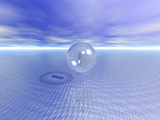 I am writing this in June of 2020, during a transmissable viral pandemic that has necessitated changes to the way that we as
humans interact. Currently the best medical advice for not becoming infected is to keep a physical distance of at least
six feet from each other. That has changed so many familiar patterns in our lives. Including things like how your broken
toilet gets fixed.
I am writing this in June of 2020, during a transmissable viral pandemic that has necessitated changes to the way that we as
humans interact. Currently the best medical advice for not becoming infected is to keep a physical distance of at least
six feet from each other. That has changed so many familiar patterns in our lives. Including things like how your broken
toilet gets fixed.
I can envision a time in the future, if our species does not wipe itself off of the planet before then, when our understanding of the world and our ability to work within it, is utterly transformed beyond our current comprehension.
Imagine a time in that future, when your toilet is broken, and in order to repair it you merely take a "photo" of it using a device that might look something like your current smart phone, then send it across space and time to me as you would a photo of youself on vacation. My device receives the "image" as I sit miles from you, and I analyze it. I then manipulate it in a way to effect repairs, and then send it back to your device, where you substitute the repaired version of your toilet for the broken toilet in your home. Perhaps it would be something like the replicator on the Starship Enterprise. This is impossible now, with our current understanding of the world. Then again, a century or two ago it was unthinkabe that mankind would be able to fly through the air.
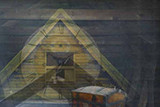 Something that IS possible with the technology that we have and can use today, is to make it easier to have common
agreement about what something looks like before it is created or built. 3-D graphics (three diminsional graphics),
go beyond CAD (computer assisted drafting), which is two dimensional and linear. 3-D allows images to be created that capture depth,
perspective, and importantly, nuance of light, reflection, color and shadow which can come nearly as close to reality as photography.
Something that IS possible with the technology that we have and can use today, is to make it easier to have common
agreement about what something looks like before it is created or built. 3-D graphics (three diminsional graphics),
go beyond CAD (computer assisted drafting), which is two dimensional and linear. 3-D allows images to be created that capture depth,
perspective, and importantly, nuance of light, reflection, color and shadow which can come nearly as close to reality as photography.
Formerly, to go that extra step to show someone what an object will look like, models and paintings were used. Still useful, as at times, just a "napkin sketch" is all that is needed to help someone visualize. But at other times that's not enough. It is really important to understand that one of the ways we humans who are sighted, understand and make sense of the world, is by actually thinking in images.
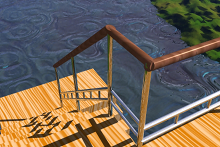 As an example of how very important it is to have accurate communication before building or creating, in order to avoid costly
and time wasting "mistakes", consider this. A producer on a TV show that I worked on kept telling the Production Designer that he wanted
to see certain colors incorperated into the set. The Production Designer did so, but the producer wasn't satisfied with what he saw. This happened several
times in a row until, in a chance conversation that the Production Designer had with the producer's wife, he learned that the producer
was color blind.
As an example of how very important it is to have accurate communication before building or creating, in order to avoid costly
and time wasting "mistakes", consider this. A producer on a TV show that I worked on kept telling the Production Designer that he wanted
to see certain colors incorperated into the set. The Production Designer did so, but the producer wasn't satisfied with what he saw. This happened several
times in a row until, in a chance conversation that the Production Designer had with the producer's wife, he learned that the producer
was color blind.
The Production Designer then reasoned that neither of them were wrong about the colors. The producer wasn't seeing the colors the Production Designer gave him, as the same colors that existed in his mind. The Production Designer did however, have the ability to try to look at things the way the producer saw the world. He showed the producer a "Color Blind" Palett of colors, the producer picked his colors, the Production Designer replicated them on the set, and they were both happy.
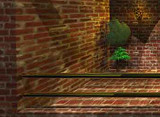 When I really came to understood the usefulness of 3-D graphics to help in conveying an idea to someone who does not necessarily
visualize concepts, in the same way that I do, was when I got a job to design a stage set for a play in a small 99 seat theater.
The owner of the theater was producing a play called Later Life, by A.R. Gurney. As so often is the case in small black box theatres, there
was little time and a tight budget for materials and labor.
When I really came to understood the usefulness of 3-D graphics to help in conveying an idea to someone who does not necessarily
visualize concepts, in the same way that I do, was when I got a job to design a stage set for a play in a small 99 seat theater.
The owner of the theater was producing a play called Later Life, by A.R. Gurney. As so often is the case in small black box theatres, there
was little time and a tight budget for materials and labor.
After reading the play and discussing what the director wanted, I sketched out a concept drawing and showed it to the producer. She couldn't quite wrap her mind around what I was showing her. I made a model and she still couldn't see my concept. I then created a 3-D image that she immediatly understood and then approved a budget for. The producer, director and the cast were happy and loved the result after it was built. I was nominated for a best set design award from the NOHO Valley Theatre League that year. I didn't win, but the honor of being recognized felt pretty good.
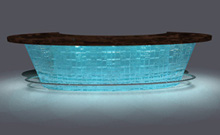 Later, while working as a painter, for another customer who was remodeling their home and wanted a design for a bar
to be built, they asked me if I had any original ideas. The architect that they had hired wasn't coming up with
anything that they liked. I began to work in a 3-D program one afternoon, and by evening I had a design that I emailed
to them. Within an hour I received a two word reply: Build it.
Later, while working as a painter, for another customer who was remodeling their home and wanted a design for a bar
to be built, they asked me if I had any original ideas. The architect that they had hired wasn't coming up with
anything that they liked. I began to work in a 3-D program one afternoon, and by evening I had a design that I emailed
to them. Within an hour I received a two word reply: Build it.
After consulting with them further about the materials to be used, the amenities that would be included and other details, I began to design the structural aspects in a CAD program (Computer Assisted Drafting Program). The framework is 1" X 1" and 1" X 2" square steel tube, with bender board covering the lower outer face as a base for the glass tile, Ipe wood bar top and all wood trim and cabinetry.
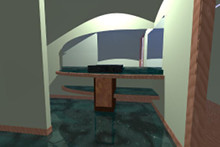 In another project for this same customer during their home remodel, they had an oddly shaped space beneath a staircase
located next to the bar that I had just built, which they wanted to turn into a "powder room". They thought it a good idea
to reflect and incorporate the design of their new unique bar into the vanity portion of the powder room design. Again using
3-D graphics, it was easy to show them ideas, discuss what they wanted, add and or change details before building. Here, this
series of graphics and photos shows the original concept, several views around the space, and the final result as it was built.
In another project for this same customer during their home remodel, they had an oddly shaped space beneath a staircase
located next to the bar that I had just built, which they wanted to turn into a "powder room". They thought it a good idea
to reflect and incorporate the design of their new unique bar into the vanity portion of the powder room design. Again using
3-D graphics, it was easy to show them ideas, discuss what they wanted, add and or change details before building. Here, this
series of graphics and photos shows the original concept, several views around the space, and the final result as it was built.
At all times, I strive to provide the highest quality workmanship and materials available in accordance with the job requirements of each individual client. I welcome all inquires of any nature gladly, and assure you that I shall endeavor to continually merit your confidence.
